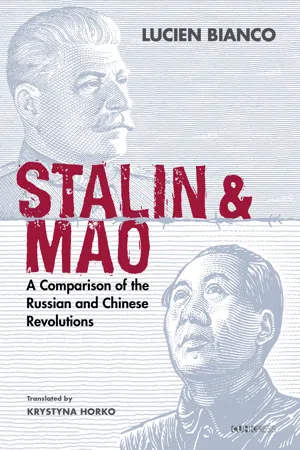
- English
- PDF
- Available on iOS & Android
About this book
China's ascent to the ranks of the world's second largest economic power has given its revolution a better image than that of its Russian counterpart. Yet the two have a great deal in common. Indeed, the Chinese revolution was a carbon copy of its predecessor, until Mao became aware, not so much of the failures of the Russian model, but of its inability to adapt to an overcrowded third-world country.Yet, instead of correcting that model, Mao decided to go further and faster in the same direction. The aftershock of an earthquake may be weaker, but the Great Leap Forward of 1958 in China was far more destructive than the Great Turn of 1929 in the Soviet Union. It was conceived with an idealistic end but failed to take all the possibilities into account. China's development only took off after—and thanks to—Mao's death, once the country turned its back on the revolution.Lucien Bianco's original comparative study highlights the similarities: the all-powerful bureaucracy; the over-exploitation of the peasantry, which triggered two of the worst famines of the 20th century; control over writers and artists; repression and labor camps. The comparison of Stalin and Mao that completes the picture, leads the author straight back to Lenin and he quotes the observation by a Chinese historian that, "If at all possible, it is best to avoid revolutions altogether."-----------------------------------------------[Lucien Bianco] has written a wise and humane book, one attuned to the ironies of revolution, a testament to a lifetime of study and reflection.—S. A. Smith, Professor of History, University of OxfordLucien Bianco is a grand historian who draws on six decades of research and reflection to make a major intellectual contribution synthesizing the results of the Chinese and Russian revolutions. Stalin and Mao drew from Lenin as they aimed to realize the ideals of bringing their countries out of backwardness and provide social justice. They were skillful political manipulators who instead brought disasters to their countries, with massive cruelties, starvation, and deaths while skillfully creating lies to sustain their leadership. Bianco writes with perspective, depth, and passion.—Ezra F. Vogel, Henry Ford II Professor of the Social Sciences Emeritus, Harvard UniversityThis deeply researched and passionately argued book by our great European Sinologist crowns decades of close observation of the Chinese revolution. By drawing out the deep and often overlooked connections between Stalinism and Maoism, Bianco makes the differences stand out in stark relief. The book is filled with original and at times surprising insights, especially in the penultimate chapter that closely compares the characters and political actions of Stalin and Mao. More than a work of comparative history, this is a critical reflection on the costs of 20th century communism by a humanistic defender of the European liberal tradition.—Andrew G. Walder, Denise O'Leary and Kent Thiry Professor, Stanford UniversityA trenchant comparison, vivid, judgmental, and passionate, based on years of research and deep reflection. Bianco's core argument is that despite significant differences the trajectories of the Stalin and Mao eras were similar. Mao made errors and committed crimes that had also been hallmarks of Stalinism. Even when Mao intended to deviate from the Stalin model, his policies were largely Stalinist in nature. The most telling example was the Chinese famine of 1959–1961 compared to its Soviet predecessor of 1932–1933. The author's explanations are entirely plausible but will no doubt cause controversy.—Thomas P. Bernstein, Professor Emeritus, Columbia University
Frequently asked questions
- Essential is ideal for learners and professionals who enjoy exploring a wide range of subjects. Access the Essential Library with 800,000+ trusted titles and best-sellers across business, personal growth, and the humanities. Includes unlimited reading time and Standard Read Aloud voice.
- Complete: Perfect for advanced learners and researchers needing full, unrestricted access. Unlock 1.4M+ books across hundreds of subjects, including academic and specialized titles. The Complete Plan also includes advanced features like Premium Read Aloud and Research Assistant.
Please note we cannot support devices running on iOS 13 and Android 7 or earlier. Learn more about using the app.
Information
Table of contents
- Half title
- Title page
- Copyright page
- Dedication page
- Quotation
- Contents
- Foreword
- Acknowledgments
- Introduction
- 1. The Laggards
- 2. Catching Up
- 3. Politics
- 4. The Peasants
- 5. Famines
- 6. Bureaucracy
- 7. Culture
- 8. The Camps
- 9. Dictators
- Conclusion
- Appendix Before and After: Yan’an, 1942–1943
- Notes
- Works Cited
- Index